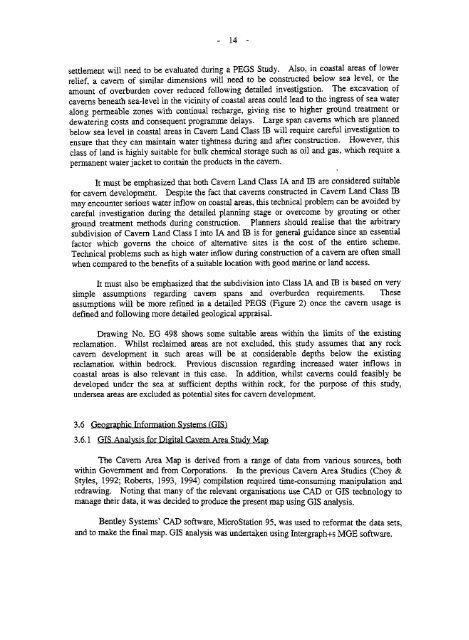miscellaneous planning standards and guidelines - HKU Libraries
miscellaneous planning standards and guidelines - HKU Libraries
miscellaneous planning standards and guidelines - HKU Libraries
You also want an ePaper? Increase the reach of your titles
YUMPU automatically turns print PDFs into web optimized ePapers that Google loves.
- 14 -settlement will need to be evaluated during a PEGS Study. Also, in coastal areas of lowerrelief, a cavern of similar dimensions will need to be constructed below sea level, or theamount of overburden cover reduced following detailed investigation. The excavation ofcaverns beneath sea-level in the vicinity of coastal areas could lead to the ingress of sea wateralong permeable zones with continual recharge, giving rise to higher ground treatment ordewatering costs <strong>and</strong> consequent programme delays. Large span caverns which are plannedbelow sea level in coastal areas in Cavern L<strong>and</strong> Class IB will require careful investigation toensure that they can maintain water tightness during <strong>and</strong> after construction. However, thisclass of l<strong>and</strong> is highly suitable for bulk chemical storage such as oil <strong>and</strong> gas, which require apermanent water jacket to contain the products in the cavern.It must be emphasized that both Cavern L<strong>and</strong> Class IA <strong>and</strong> IB are considered suitablefor cavern development. Despite the fact that caverns constructed in Cavern L<strong>and</strong> Class IBmay encounter serious water inflow on coastal areas, this technical problem can be avoided bycareful investigation during the detailed <strong>planning</strong> stage or overcome by grouting or otherground treatment methods during construction. Planners should realise that the arbitrarysubdivision of Cavern L<strong>and</strong> Class I into IA <strong>and</strong> IB is for general guidance since an essentialfactor which governs the choice of alternative sites is the cost of the entire scheme.Technical problems such as high water inflow during construction of a cavern are often smallwhen compared to the benefits of a suitable location with good marine or l<strong>and</strong> access.It must also be emphasized that the subdivision into Class IA <strong>and</strong> IB is based on verysimple assumptions regarding cavern spans <strong>and</strong> overburden requirements. Theseassumptions will be more refined in a detailed PEGS (Figure 2) once the cavern usage isdefined <strong>and</strong> following more detailed geological appraisal.Drawing No. EG 498 shows some suitable areas within the limits of the existingreclamation. Whilst reclaimed areas are not excluded, this study assumes that any rockcavern development in such areas will be at considerable depths below the existingreclamation within bedrock. Previous discussion regarding increased water inflows incoastal areas is also relevant in this case. In addition, whilst caverns could feasibly bedeveloped under the sea at sufficient depths within rock, for the purpose of this study,undersea areas are excluded as potential sites for cavern development.3.6 Geographic Information Sygtenis (GIS)3.6.1 GIS Analysis for Digital Cavern Area Study MapThe Cavern Area Map is derived from a range of data from various sources, bothwithin Government <strong>and</strong> from Corporations. In the previous Cavern Area Studies (Choy &Styles, 1992; Roberts, 1993, 1994) compilation required time-consuming manipulation <strong>and</strong>redrawing. Noting that many of the relevant organisations use CAD or GIS technology tomanage their data, it was decided to produce the present map using GIS analysis.Bentley Systems' CAD software, MicroStation 95, was used to reformat the data sets,<strong>and</strong> to make the final map. GIS analysis was undertaken using Intergraph+s MGE software.
















